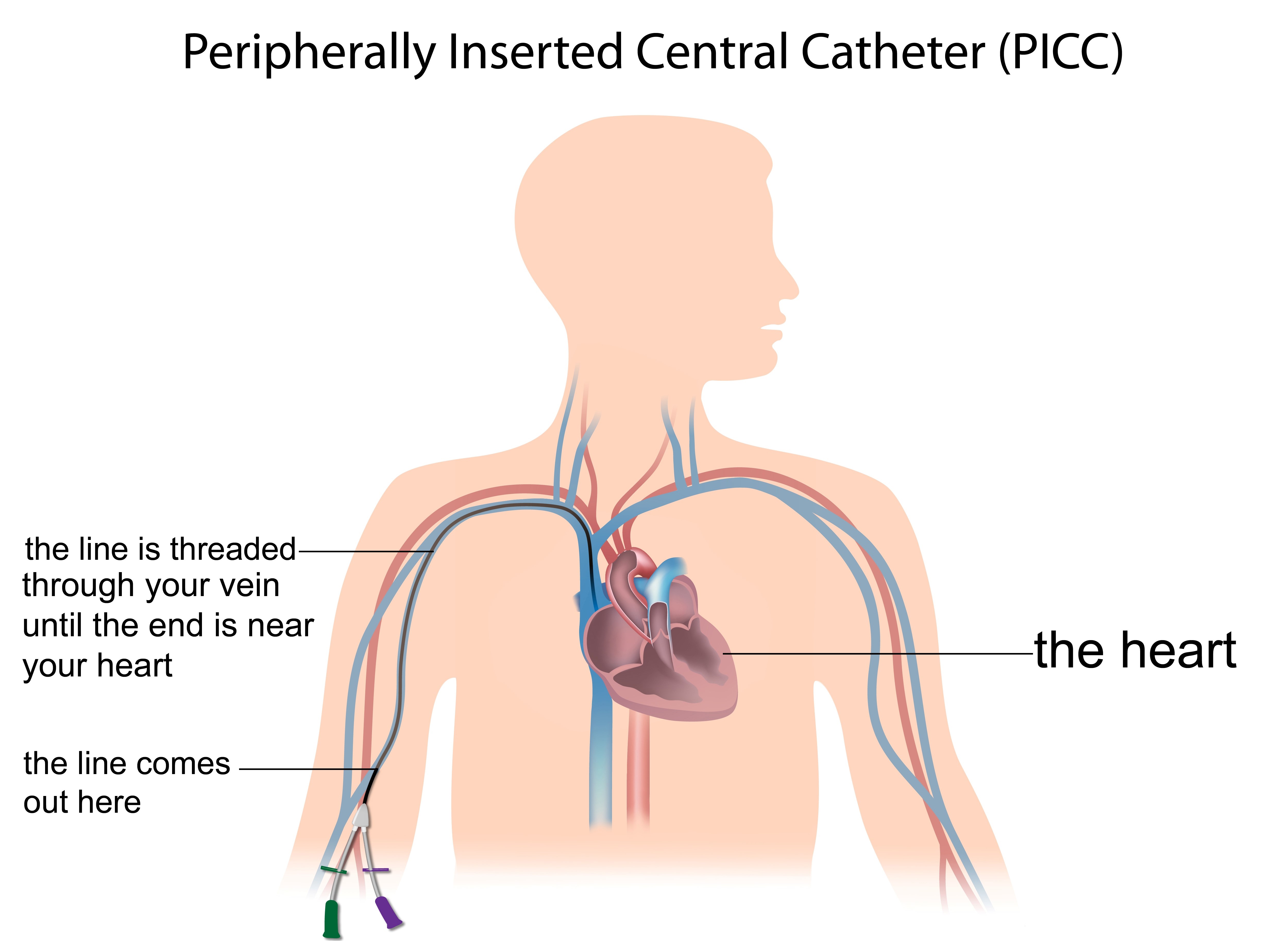Care of your peripherally inserted central catheter (PICC)
A guide for patients and their carers
What is a PICC?
A PICC is a peripherally inserted central catheter. It is a thin flexible tube that is inserted into a vein in the upper arm. The PICC is then threaded along the vein so that the tip lies in one of the large veins in the chest. A specially trained nurse or doctor will insert your PICC. Not all patients are suitable for a PICC, so a nurse will assess you before one is inserted.
The illustration below shows the PICC line, and where it enters the vein at the inside of the upper arm (see diagram below).

How is it put in?
First, the procedure will be explained to you with the opportunity to ask questions before signing a consent form. An ultrasound machine will be used to identify a suitable vein. Once identified the area is numbed with a local anaesthetic injection. The PICC line is then threaded through the needle, into a large vein that leads to your heart. The needle is removed at the same time. The procedure usually takes about 60 minutes. Occasionally it may be difficult to thread a PICC line. However, most people do not find the procedure painful or uncomfortable. A Sherlock ECG sensor device will be placed on your chest to determine the correct position of your line. A chest x-ray may be required to confirm this. The PICC will be held in place by a small device called a SecurAcath or statlock and covered with a clear, waterproof dressing.
What are the benefits of having a PICC line?
- A PICC can be used to give fluids, antibiotics, chemotherapy, anti-cancer drugs and other drugs directly into the vein. It can also be used for taking blood samples.
- PICC lines are inserted when a central line is needed for short term use.
- They are ideal for people who have small veins which are difficult to find or access, or for people who are very anxious about needles.
- A PICC is sometimes used temporarily for people who should ideally have a tunnelled central venous catheter but are not able to have one because, for example, they are on blood thinning therapy such as Warfarin or Aspirin, have abnormal blood count results, or are unable to lie flat. In this situation, a PICC means treatment can be started without delay.
- A PICC can be used for total parenteral nutrition (TPN). This is a type of tube feeding for nutritional support, usually used for people who cannot take nutrients in through their digestive system.
Are there any alternatives to a PICC line?
If you do not have a suitable vein for a PICC line, a tunnelled central venous catheter or a TIVAD (totally implantable vascular access device) may be considered. Your doctor or nurse specialist will discuss the options with you.
What are the risks of PICC insertion?
As with most procedures there is a small risk of complications which may include:
- Infection – there is a small risk of infection after having a PICC inserted.
- The catheter tip in the vein may not be in the correct position and sometimes needs to be adjusted into a better position.
- It is possible for a blood clot (thrombosis) to form in your vein at the tip of the line or around the line within the vein.
- Split in the PICC line. It is uncommon but occasionally the PICC line can break and split.
- Bleeding and some bruising around the insertion site, especially in people whose blood does not clot normally.
- Accidental puncture of the artery which may cause bleeding.
- Nerve damage – during the procedure you may feel a shooting pain down your arm if the needle touches a nerve.
Please make sure you have answers to all your questions before you consent to the procedure.
Who will care for it?
While you are in hospital, the nursing staff will look after your PICC. This involves:
- Cleaning the exit site and applying a new dressing weekly.
- Flushing the line weekly to prevent blocking when it is not in use.
When you leave hospital, we will arrange for you to have your line redressed and flushed once a week by the district nurses. We will also give the district nurse a letter outlining how to care for your PICC and all the equipment needed for the first flush.
Please note that if you experience a cold and shivery attack during or after flushing your line seek medical advice immediately as this could be the beginning of an infection.
How will I know if something is wrong?
Sometimes problems can occur while you have a PICC line. If you suspect that something is wrong, or if you have any of the following seek medical help right away:
- If you have a temperature above 37.5c, fever, chills or generally feel unwell. This could be the beginning of an infection.
- Oozing around the line.
- Cracks or leaks in the line.
- Pain, redness or swelling around the site, in your neck, arm or hand – this could be a sign that the line tip has moved and a blood clot has formed in one of the veins. If a clot does form, you will be given some medication to dissolve it.
Frequently asked questions
Can I eat and drink before having my PICC inserted?
We recommend a light diet before having your PICC inserted.
Can I have a bath or a shower and swim?
As a general rule we encourage people with PICCs to take a shower rather than a bath because of the risk of infection if the PICC is submerged in bathwater. You should not go swimming whilst you have a PICC line.
Can I lead a normal social life?
Having a PICC in place should not interfere with your social life. However, having chemotherapy may mean that you do not feel like certain social activities immediately after treatment or if your blood counts are low. Your nurse or doctor will give you more specific information.
Can I play sports?
Sports such as tennis or golf or vigorous gym exercises are discouraged. There is a risk that your PICC could become dislodged because of excessive upper body movement. However there are many other pursuits which are acceptable. If in doubt ask your nurse or doctor.
How the PICC line is removed:
When you don’t need a PICC line any more, it will be taken out. A nurse will usually do this for you in an outpatient department. It will be gently pulled out and the area where the PICC line was put in will be covered with a dressing. This is a painless procedure and only takes a few minutes.
Date of publication: 01/04/2024
Reference code: PIL245/IND029
Review date: 01/04/2027

